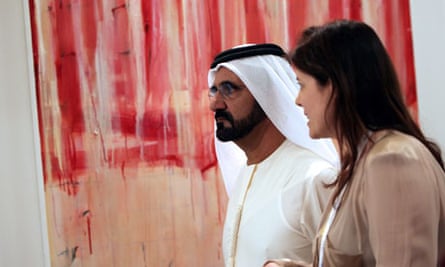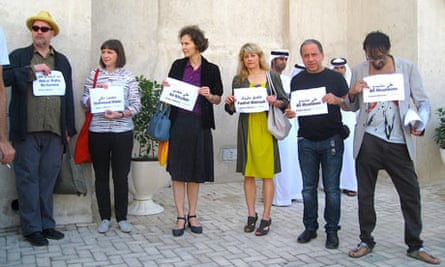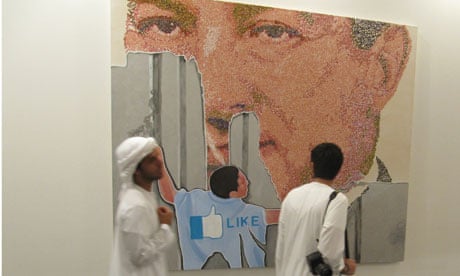Last week saw the opening of Art Dubai, the Middle East's biggest art fair, and the Sharjah Biennial in Dubai's neighbouring emirate. On the same day, the Gulf Co-operation Council (GCC) sent troops to help crush the resurgent protests in Bahrain. Though the troops are probably from Saudi Arabia, the United Arab Emirates – a key member of the GCC – is now participating in the Arab spring, but on the wrong side. Suddenly, Art Week and the well-respected Sharjah Biennial assumed exponentially more meaning. The bubble of the art world didn't burst – the art fair and the biennial are patronised by Dubai and Sharjah's ruling families respectively – but the membrane between art and politics was infiltrated in ways alternately impressive, opportunistic, courageous and frustratingly inadequate.
Dubai's art scene is booming, even if the city is not. Its art fair is now in its fifth year and has 82 galleries – up from 72 last year – hailing from 43 countries, mostly from the "central world", of which Dubai claims to be the capital. The fair took place in the halls of the Madinat Jumeirah hotel, next-door to the iconic sail-like building of the seven-star Burj al Arab. On the opening morning, I latched on to the entourage of Dubai's ruler, Sheikh Mohammed bin Rashid al-Maktoum, taking a tour of the fair. Sheikh Mo clearly appreciates the entrepreneurial spirit of the fair and the cultural cachet it gives his maligned city, the victim of seemingly insatiable schadenfreude since the crash two and a half years ago. (The latest screed, maybe the most hysterical and myopic in the new tradition of Dubai-bashing, comes from AA Gill in Vanity Fair.)

Front-line art
I deviated from the sheikh's tour to take in the booth of Artspace, one of eight galleries from Dubai at the fair. It was the "revolution" booth, with several works referencing Egypt. Khaled Hafez's mural-sized canvas features collages of soldiers and protesters in Tahrir Square on a background of blobby pixels and dribbles of paint. "From the front lines," whispered a voice behind me as I leant in to the painting. The voice belonged to Hafez himself, who explained that the piece started off as an abstract colour field. But with the revolution unfolding as the paint dried, he transformed it into a tribute to his protesting comrades in Cairo's art scene, creating an "open source" collage of their snapshots of the action.
Hafez, 47, has long made politically charged paintings and video work. "My generation spent so much time blaming and criticising," he said. "But it never crossed our minds to spend 18 days in Tahrir Square simply demanding what we want." Artists of the younger generation were acting as citizens first, aesthetic ciphers second, which seems to be a good model for how to be a political artist in revolutionary times (American art critic Ben Davis wrote very eloquently on this recently).
Artspace showed another insta-response to revolution: a painting called Bye Bye Hosni, by the Moroccan artist Zakaria Ramhani, of a protester with a huge Facebook-like button on his back, tearing down a poster of Mubarak. It's an uncomplicated statement of solidarity, but in the context of the art fair feels opportunistic and overly media-friendly – a too-perfect metonym of the revolution.
Only a handful of the galleries at Art Dubai are recognisable to the many people here on the bandwagon of the western art fair circuit. Assar Art Gallery from Tehran is one of the unknown galleries that makes this fair more exciting than the big daddies. Assar's standout work was a mock stain-glass window by Iranian artist Roxana Manouchehri, featuring an intricate mixture of Arabic and Gaelic text, Christian saints and Islamic iconography. The gallerist told me Manouchehri was inspired by a recent trip to Ireland. When I asked her about the situation in Iran, she told me that she teaches at the University of Art in Tehran; Sane Jaleh, the student killed in the recent protests and absurdly claimed by the government as a victim of the protestors, was one of her students. It was another moment where the bubble burst for a second, only to reform when the next sheikh or high-heeled gallerista swished by.
Bahrain itself makes an appearance at the fair in a series of beautiful photos by Camille Zakharia at the Lucy Mackintosh gallery, from Lausanne. Zakharia documents the ramshackle fisherman's huts and piers that jut out from Bahrain into the Gulf. The photos are part of the Reclaim project that appeared at the Venice architecture biennale last summer, investigating how rampant land reclamation around the island city state has cut off entire neighbourhoods – both Shia and Sunni – from their traditional relationship with the sea. These endangered shelters – hang-out spots for drinking tea, playing games and watching TV (one has a satellite dish precariously rigged to it) – are a touching picture of vernacular life in Bahrain, a mental background on which to project the current violence. The Reclaim project was initiated by Bahrain's Ministry of Culture, run by Sheikha Mai bint Mohammed Al Khalifa. She was supposed to give a lecture on the project at the fair, but pulled out at the last minute.
"It wouldn't be appropriate for us to appear at an art fair at a moment like this," Noura Al-Sayeh, head of architectural affairs at the ministry and curator of the Reclaim project, told me. But she was keen to point out that "art shouldn't be undermined as frivolous or unnecessary. Its function is to fill in the gaps in a radicalised society."
Implied politics
Escaping the strange bubble of the art fair, I took a bus to Sharjah, a conurbation of Dubai about 10 miles to the north, but much older and with something Dubai lacks: a large, well-established art museum. It has been almost completely taken over by the biennial – the 10th since 1993 and featuring 76 artists. The only hint of the "festivalism" familiar in most biennials here is a pretty innocuous-looking replica rocket, in surrender-flag white, pointing at the sky in front of the museum. The rocket is a Cedar 4, made by a group of scientists and mathematicians in the 1960s. They launched rockets not for military purposes but merely to study the science of trajectory and ballistics. The Cedar 4 was resurrected, and a film is being made about it by Lebanese artists Joana Hadjithomas and Khalil Joreige. The project is political only by implication; Hadjithomas, hovering nearby, would only say that "this was a project made by dreamers" and she wanted to "bring back" the importance of such people.
Predictably, the politics at the biennial was slower and more considered than at the fair, which can respond faster to current events and with less intellectual burden. A mesmerising video by no fewer than four artists – Jane and Louise Wilson, Shumon Basar and Eyal Weizman – tells the story of the murder of Mahmoud al-Mabhouh, the Hamas officer assassinated by Mossad in Dubai last year. Similarly strategic is the selection of Harun Farocki's 1993 film Videograms of a Revolution: a documentary of the Romanian revolution in 1989 stitched together from home videos and lost TV footage, which shows a heroic act of aggregation that the likes of Facebook and YouTube now do for us.

Meanwhile, a very direct political action took place that morning as Sharjah's Sheikh Sultan Bin Mohammed al-Qassimi was having his inaugural tour of the biennial. Outside the museum, a groups of artists including Ibrahim Quraishi handed out pieces of paper bearing the names of Bahrainis killed in the protests. "We in the artworld are not living in a vacuum," Quraishi told me by phone after being released from the interrogation that swiftly followed. "We didn't do it for show, but to have people carrying around these names with them all day," he said. Quraishi was only released after five hours of questioning by the Sharjah internal security forces and after giving assurance that he was not trying to bring down its ruling regime. Solidarity feels good, but the effect of Quraishi's action may be counterproductive. Haig Aivazian, a co-curator of the biennial who was also taken for questioning, told me: "I would support a gesture of solidarity, but this one was not effective. The very small margin of freedom that the Sharjah Foundation has created for the biennial has been compromised."
A more constructive act of solidarity emerged the next morning over another pertinent issue in the region: migrant workers' rights, in this case for the new Guggenheim in Abu Dhabi, designed by Frank Gehry. Walid Raad, a Lebanese artist participating in the biennial, announced a boycott by a group of 130 artists, curators and writers unless the Guggenheim Foundation ensures construction workers are given fair conditions. "Artists should not be asked to exhibit their work in buildings built on the backs of exploited workers," Raad said. "Those working with bricks and mortar deserve the same respect as those working with cameras and brushes." The Sharjah Biennial is implicated as its chief curator, Suzanne Cotter, is also chief curator of the new Guggenheim.
Human Rights Watch reports have documented rampant abuses on Saadiyat island, where the Guggenheim will stand alongside a Louvre outpost designed by Jean Nouvel, a national museum by Norman Foster and a Zaha Hadid-designed opera hall. Workers are forced to repay extortionate recruitment fees, have their passports revoked upon arrival, and are subject to fines if they quit. Maybe the local Gulf News knew the artists' declaration was coming: the day before, they ran a puff piece with the headline "Cosy home for Saadiyat workers", reassuring readers that everything is rosy on Saadiyat, which literally means "island of happiness".
Art and politics are an awkward pairing at the best of times. But Art Dubai and the Sharjah Biennial, however awkwardly and with whatever compromised means, are bringing the invigorating oxygen of cultural and political debate to the region. Let's hope it continues, inshallah.

Comments (…)
Sign in or create your Guardian account to join the discussion